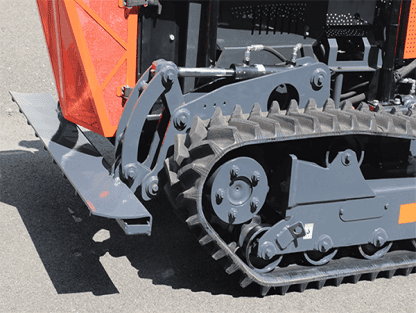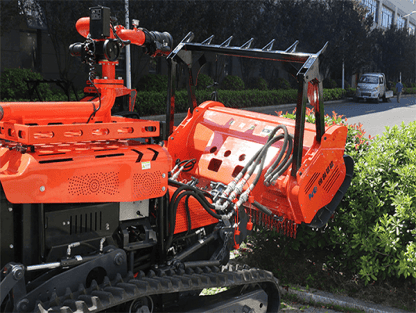
Forestry mulching has become an increasingly popular solution for land clearing, vegetation management, and wildfire prevention. With the introduction of advanced machinery like forestry mulchers and remote control mulchers, the process has reached new heights of safety, efficiency, and adaptability. But are forestry mulchers really worth the investment? This article will delve deep into the capabilities of these machines, their applications, and whether they offer a cost-effective solution for land management tasks.
A forestry mulcher is a specialized machine used for land clearing operations, shredding trees, bushes, and vegetation into mulch. The mulch is then left on the ground, enriching the soil and preventing erosion. Forestry mulching is an eco-friendly alternative to traditional land-clearing methods like bulldozing, which can disturb the soil and harm the ecosystem.
Modern forestry mulchers, such as remote control mulchers, are designed to operate in challenging terrains, including steep slopes and dense forests. These machines consist of two main parts: a power platform and a working device. Equipped with high-torque clearing heads and durable alloy cutter heads, forestry mulchers can handle various tasks, from clearing forest fire isolation belts to transporting materials in mountainous areas.
To answer whether forestry mulchers are worth it, let’s evaluate their features, benefits, and applications:
Forestry mulchers are incredibly efficient. A high-quality mulcher can clear up to 15 acres per day, depending on the density of the vegetation. Compared to manual labor, which could take weeks for the same task, forestry mulchers save both time and money.
| Method | Speed | Cost Efficiency |
|---|---|---|
| Manual Labor | 0.5-1 acre per day | High labor cost |
| Bulldozing | 5-10 acres per day | Soil disturbance |
| Forestry Mulching | Up to 15 acres per day | Environmentally friendly, cost-efficient |
With remote control mulchers, the operator can control the machine from a safe distance. These machines are designed for hazardous environments, such as steep slopes or areas prone to wildfires. Remote operation ensures that the operator remains out of harm’s way.
Forestry mulching converts vegetation into nutrient-rich mulch, which can improve soil quality and encourage regrowth. It avoids the need for burning or hauling debris, reducing carbon emissions and environmental impact.
While the initial cost of purchasing a forestry mulcher may seem high, the long-term savings in labor, fuel, and time make it a worthwhile investment. For those who need mulching services occasionally, forestry mulching rental options are available, offering flexibility without the burden of ownership.
Modern forestry mulchers are equipped with interchangeable heads, making them suitable for multiple tasks, including:
Forestry mulching equipment comes in various types, each designed for specific applications:
The cost of using a forestry mulcher depends on the type of machine and the project size. On average, the cost ranges from $150 to $500 per hour. Larger, more powerful mulchers such as excavator-mounted models tend to be on the higher end of the spectrum.
| Mulcher Type | Hourly Cost |
|---|---|
| Skid Steer Mulcher | $150-$250 |
| Excavator Mulcher | $300-$500 |
| Remote Control Mulcher | $200-$400 |
Most forestry mulchers can handle trees up to 6-8 inches in diameter with ease. High-powered models can cut through trees as large as 12-15 inches in diameter. For even larger trees, additional equipment may be required.
The area a forestry mulcher can clear in a day depends on factors like vegetation density, terrain, and the type of mulcher. On average:
Yes, most forestry mulchers can grind stumps down to ground level. However, they may not completely remove the stump below the surface. For projects requiring full stump removal, additional stump grinding equipment may be necessary.
High-flow hydraulic systems are essential for operating a forestry mulcher efficiently. High-flow systems provide the necessary power to handle dense vegetation and large trees. Without high-flow capabilities, the mulcher may struggle to perform effectively.
| Aspect | Forestry Mulching | Bush Hogging |
|---|---|---|
| Vegetation Management | Handles dense vegetation and trees | Primarily for grass and light brush |
| Soil Protection | Minimal soil disturbance | Higher risk of soil damage |
| Eco-Friendliness | Creates nutrient-rich mulch | Leaves debris behind |

While forestry mulching has many advantages, it does come with some limitations:
Yes, grass and other vegetation typically grow back after forestry mulching. The mulch left behind enriches the soil, encouraging regrowth. However, the rate of regrowth depends on factors like soil quality, weather conditions, and the type of vegetation.

What is a forestry mulcher used for?
A forestry mulcher is used for land clearing, vegetation management, wildfire prevention, and creating firebreaks.
How long do forestry mulcher teeth last?
Forestry mulcher teeth typically last 100-500 hours, depending on the terrain and usage.
Can a forestry mulcher handle rocky terrain?
Yes, many forestry mulchers are designed to work on rocky terrains, but excessive rocks can wear out the mulcher teeth faster.
Is forestry mulching better than bulldozing?
Yes, forestry mulching is more eco-friendly and causes less soil disturbance compared to bulldozing.
How much does it cost to rent a forestry mulcher?
The rental cost of a forestry mulcher ranges from $200 to $500 per day, depending on the model and location.
In conclusion, forestry mulchers are worth the investment for those involved in land management, fire prevention, or forestry operations. Their efficiency, safety, and versatility make them an invaluable tool for tackling complex terrain and vegetation challenges. Whether you choose to purchase or rent, forestry mulching offers a cost-effective and environmentally friendly solution for a wide range of applications.